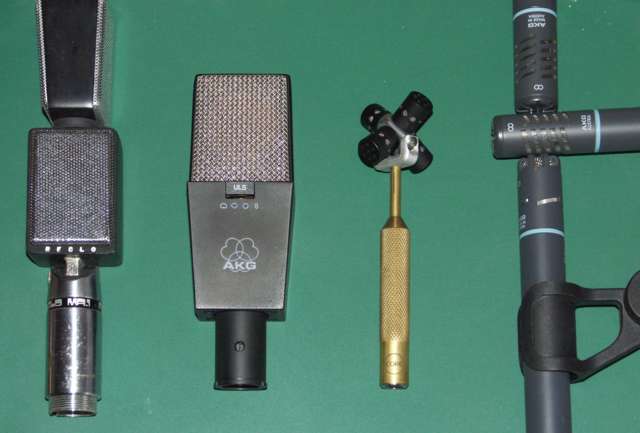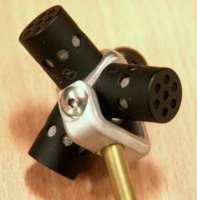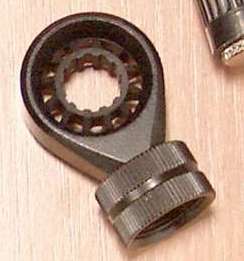Design Features
Size comparison
My immediate impression when I received the TetraMic was how tiny it is! This is clear from the picture on the start page of these notes. I also find the plain unlacquered brass finish looks a bit prototypish. To compare its size with some other well-known mics, the photo below shows it alongside a Reslo ribbon (the rare, late MR1 version), an AKG C414 ULS, and a native B-format array of three AKG Blue Line mics.

Capsule arrangement
The capsules (which are cardioid rather than sub-cardioid) are mounted very compactly on a nicely made tetrahedron. They could hardly be closer; but the diaphagms fall on a somewhat larger sphere than do those of the SoundField microphones whose capsules are purpose made to clamp together at their edges.
The tetrahedron is held in a bracket that appears to be attached to the slim end of the body by an interference fit; it seems robust, but I am being very careful with it! The top of the main body is angled to reduce interference with the polar diagrams of the capsules as far as possible.

Shockmount
The shockmount is amazingly compact. It consists of two rubber rings moulded together with bridges linking them; the larger is held in a metal ring, and the smaller fits snugly over the mic. The fit is quite tight, and I prefer not to push the milled section of the TetraMic's body into the mount; as a result, it cannot be used to hold the mic in a horizontal orientation, as it is too floppy to hold it unbalanced. It works great with the mic standing or hanging vertically, however.
I have noted elsewhere the slight restriction of having the mounting thread fixed horizontally - this is easily dealt with.
(Update: I now use a Rycote shockmount rather than the comparatively limited Core Sound one; this is described in an additional page on this site.)

Serial Number
Each TetraMic has a serial number which is marked on the back of its body. The VVMic software uses a parameter file that is supplied with each mic to correct the sensitivity and frequency responses of the capsules as part of combining them to generate the B-format signals. If you should have more than one TetraMic, it will be important to write down which is used for any recording!
Mine is 2007, which I like because I bought it in that year! I guess they started at 2000, and I have an early example.
 The capsules each have a number scratched on them, presumably to identify them as they are selected into matching sets for each TetraMic. As any sensitivity and frequency response differences can be corrected in the software (which is tailored for each mic), the selection must be aimed primarily at parameters that cannot be so corrected, such as the ratio of the rear null to forward sensitivity.
The capsules each have a number scratched on them, presumably to identify them as they are selected into matching sets for each TetraMic. As any sensitivity and frequency response differences can be corrected in the software (which is tailored for each mic), the selection must be aimed primarily at parameters that cannot be so corrected, such as the ratio of the rear null to forward sensitivity.
